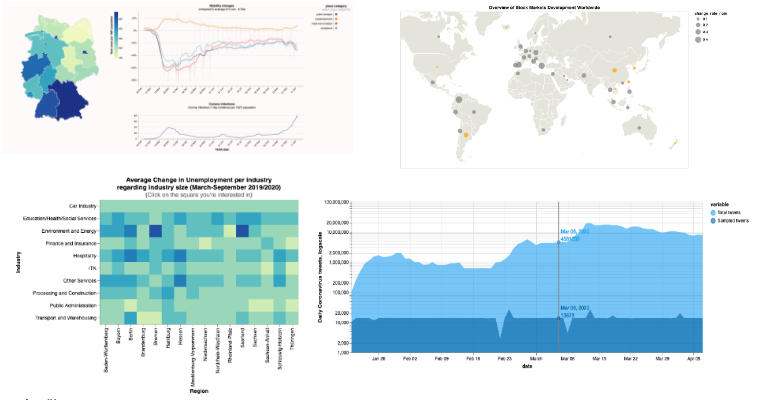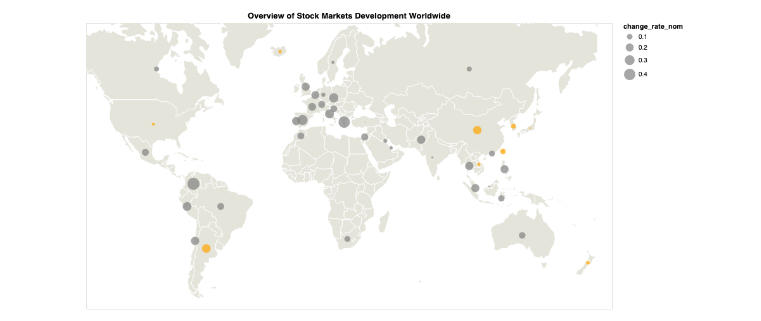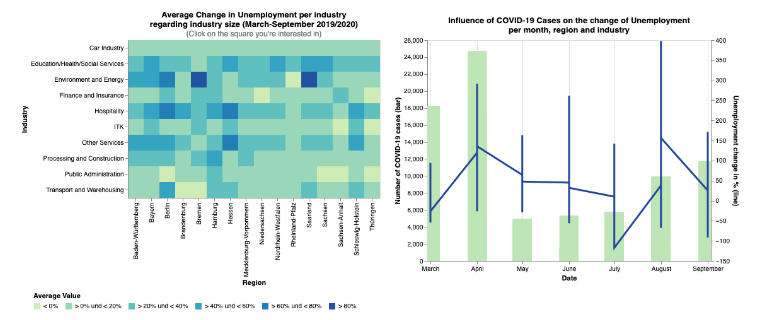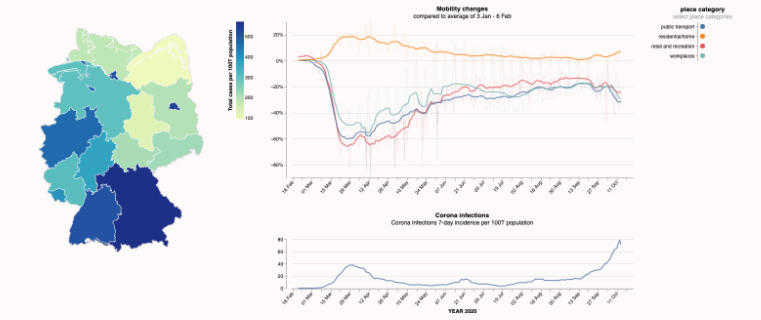Lecture with Exercise: Data Visualization
(L: 19328301 E: 19328302)
| Type | Lecture with Exercise |
|---|---|
| Instructor | Dr.-Ing. Christoph Kinkeldey |
| Start | Oct 05, 2020 | 10:00 AM |
| end | Oct 23, 2020 | 03:00 PM |
| Time | Mon - Fri 10 am - 12 pm and 1 pm - 3 pm Interested? Join us for the info meeting Sep 24, 2020 | 11 am - 12 pm |
| Note | The lecture is a block course and is offered in the summer break of the winter term (Oct. 05, 2020 - Oct. 23, 2020)! |

Course Description
The rapid technological development requires the processing of large amounts of data of various kinds to make them usable by humans. This challenge affects many areas of life today. Especially in research, economy, and politics data visualization is used to explain information and correlations by graphical representation, to explore them by visual analysis, and to support decision making. The goal of this course is to familiarize students with the principles, techniques, and algorithms of data visualization and to develop practical skills for designing and implementing data visualizations.
This course teaches students the fundamentals of data visualization with current content from research and practice. At the end of the course the students will:
- know the essential theoretical basics of visualization for graphical perception and cognition,
- know and be able to apply methods for the visual coding of data, as well as methods of interactive visualization
- understand and be able to apply algorithms and techniques for visualizing data (diagrams, graphs, maps), including methods of interaction
- be able to critically evaluate visualization solutions, and
- have practical skills in the design of visualizations and their implementation.
The course is aimed at students who are interested in using data visualization in their work as well as students who want to develop visualization tools. Basic knowledge in programming (Javascript, Python) and data analysis (e.g. R) is helpful.
Besides participating in the discussions in the course, students complete several programming and data analysis tasks, as well as a final project as an executable visualization tool. Students are expected to document and present the results of the tasks and the project.
Please note that the course focuses on how data is visually coded, presented, and analyzed once the structure of the data and its content is known. Explorative analytical methods for discovering insights in data are not the focus of the course.
Here you can find our Code of Conduct.
Literature
Text Book
Munzner, Tamara. Visualization analysis and design. AK Peters/CRC Press, 2014.
Additional Literature
-
Interactive Data Visualization for the Web, 2nd Edition. Scott Murray, O'Reilly Press. 2017.
-
Yau, Nathan: Visualize This: The FlowingData Guide to Design, Visualization, and Statistics. Wiley Publishing, Inc. 2011.
-
Spence, Robert: Information Visualization: Design for Interaction. Pearson. 2007.
Student Project Results
Group 1: The Impact of COVID-19 on Stock Market
2020 continues to surprise. A pandemic, the shutdown of the global economy, the deepest recession since the 1930s, a global equity market collapse and now, record highs for the U.S. equity market. We’re still in the early recovery phase of the cycle following the COVID-19 recession. This implies an extended period of low-inflation, low-interest-rate growth—an environment that usually favors equities over bonds. In this project, we will answer the following questions
- What does global stock market really look like?
- Why are there significant differences of stock development among countries and companies in COVID-19?
- How to make investment during corona?
For more information visit the project website.
Group 2: Unemployment in Germany during COVID-19
On March 11th, 2020, the WHO declared COVID-19 a pandemic.
Consequently, the project page visualizes the impact of the COVID-19 pandemic on the change of unemployment, exemplary on Germany. Regarding monthly data from March 2020 until September 2020, the change of unemployment will be compared to the same indicator and period in 2019 to indicate whether there was an increase in unemployment in 2020 due to COVID-19. The analysis is based on different datasets from the “Bundesagentur für Arbeit” concerning the unemployment indicator and a dataset from the “Robert-Koch Institut” concerning COVID-19 cases. To get a holistic view, the analysis takes place from three different perspectives, namely the classification of regional effects on the labor market, implications on different industrial sectors, and, finally, a combination of both perspectives to enable a differentiative view on the impact of the COVID-19 pandemic on both levels, federal and industrial.
For more information visit the project website.
Group 3: Impact of Covid-19 on mobility behaviour
The ongoing Covid-19 pandemic continues to keep governments and the general public on high alert. Among all the news of the economy shrinking and Trump possibly losing the election due to Covid-19, we asked ourselves:
How did the mobility behavior of the public change as a response to the ever changing case numbers and restrictions established by local and federal governments?
With the help of the Google Mobility Report we will try to visualize the data, that answers the question above.
For more information visit the project website.
Group 4: Corona & Twitter: A conversation-trend analysis
During the last decade, twitter has emerged as the primary discussion platform online for everybody who is or believes to be important. Therefore, a colossal event like a global pandemic will not just be a major topic on twitter, but looking at how it is discussed there can be quite enlightening. For everybody, who is a bit tired of looking only at infection numbers all the time, we offer some alternative numbers about the coronavirus pandemic.
For this, we have taken a total of about 1.1 million random English tweets between January and April that thematized corona and analyzed them.
For more information visit the project website.
